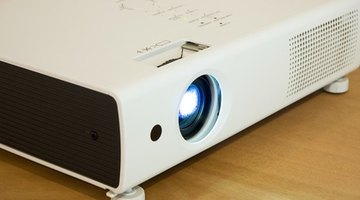Audiovisual aids can be a great tool to use in classrooms. Often they can spice up otherwise dull topics, keep students more engaged in their lesson and enliven their imaginations. Video presentations, slide shows, PowerPoint and other media have revolutionized the way teachers reach their students. But these aids are not without their disadvantages. It is important to weigh both the pros and the cons when considering how you will use audiovisual aids in your classroom.
Technical Problems
Regardless of your equipment, there are many things that could go wrong that may derail your presentation. A bulb might burn out on your projector or it might be blurry or hard to focus. When using a PowerPoint presentation, font and colors may show up differently on screen or the music and sound might not play. CDs can skip. DVDs may be scratched or not compatible with your player.
Student Distractions
Visual aids are more of a distraction if used throughout the entire presentation versus during key points. Special effects and light from the projector can draw attention away from the speaker. Too much information can also be distracting, because the students will be trying to read and/or take notes while the speaker has moved on to the next subject. There also may be too many slides for the students to interpret, or the audio and visual may not match up. An entertaining video can take the focus off the speaker and the presentation, while a dry video and low lighting can put students to sleep.
Expenses
Professionally put together audiovisual aids can be expensive. Slides, videos, and films can cost money unless borrowed from a library, and the necessary equipment can be cost-prohibitive. Due to budget constraints, some schools may not have enough audiovisual equipment for every classroom, and availability could be limited.
Time
Audiovisual presentations can take a considerable amount of time to prepare. It takes time to produce your own video or slides. Films may be difficult to obtain, or it can take time to get permission to use them. Posters and transparencies may require extensive preparation. Creating a PowerPoint presentation can also be time consuming. Time spent in preparing these materials could take away from the time it takes to prepare a clear, well-organized lesson plan.
Space
If you choose to use an audiovisual aid, the size of the room should be taken into consideration. It is critical that all students are able to see or hear your presentation. If the the room is too large for everyone to see the visual aid, or if part of your audience is forced to view the presentation at odd angles, some students will struggle to keep up with your lesson.
Convenience
Certain audiovisual aids such as VCRs for older video recordings, can be bulky and difficult to transport.
Related Articles
References
Writer Bio
Marie Liberty has been writing since 1998. She is the author of "Little Miss Right Now" and her articles have appeared in the "Blackwater Review," "Voices" and "Northwest Florida Daily News." Liberty is certified in elementary education and has a Master of Science in psychology from Troy State University.










